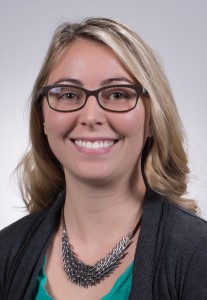New to MLGSCA – Melissa Leigh Johnson
Posted on May 23, 2016 by Bethany Myers | No Comments
2. What is your current position? In September 2015, I began serving the Phoenix Biomedical Campus (PBC) as a Health Sciences Librarian, supporting the students and faculty involved in Northern Arizona University (NAU)’s graduate programs (Doctor of Occupational Therapy, Doctor of Physical Therapy, Master of Physician Assistant Studies, and Master of Athletic Training). I am the sole NAU librarian on this campus, working alongside University of Arizona (UA) librarians, Kathleen Carlson and David Bickford.
Mainly, in addition to serving as a member of NAU’s Teaching, Learning, and Research Services librarians, I provide library instruction and ensure the availability of quality reference materials to support PBC students and faculty in their studies, teaching, and research.
3. What do you enjoy most about your current position? As a single librarian supporting an extended campus, I enjoy the extreme variability in the composition of my daily work. I get to experience nearly every aspect of academic librarianship from collection development, cataloguing, and web design to student consultations, supporting faculty research, and teaching, all constantly rotating in and out of my workflow.
Additionally, as necessitated by the frequently changing states of healthcare, education, and library science, I enjoy countless professional growth opportunities especially in the forms of online courses, conferences, and cross-institutional interactions with my colleagues.
These two aspects combine to create a work environment in which learning and collaboration are requisite and applauded, which serve my own interests and values exceedingly well.
4. What do you think is the most interesting or challenging issue in librarianship today? One challenging issue that I repeatedly encounter is the perception of librarianship, from both critical and public perspectives. Librarians take on varying roles as interpreters, guides, and to some as gatekeepers. At our core, we are often the middlemen between knowledge and its seekers, a powerful position indeed. The ethical constitution and soundness of this role must be ensured actively, from employment of librarians with diverse characteristics, backgrounds, knowledge, and experiences to the types of information we provide and the modes by which we make it accessible.
Accurate representation and promotion of what exactly it is that we do plays a role in this. It seems like the general public’s perception or understanding of libraries has not caught up with the actuality of libraries, which is due in great part to our own lack of interest, perceived or not, in self-promotion. It is likely that most of our own friends and families outside of Library Land are confused as to what it is we do, and cannot be counted on to accurately describe our responsibilities and goals. Convincing those not directly involved with libraries that we are needed and impactful, and ensuring that we are, despite our lack of diversity, is a huge challenge.
One solution may be for librarians to be more vocal, exacting, and inviting about the profession in order to attract a wider variety of potential librarians; this would help to ensure equal access to information for all from the inside out. A faculty member once shared with me that the care provided by a healthcare professional to a patient is most effective when the professional and the patient are the most similar. Perhaps this also rings true for information providers.
5. Please provide a link that made you think (an article, video, blog post, other webpage, etc. that you found to be interesting or thought-provoking): I learned that my knowledge of statistical analysis was lacking after failing to accurately interpret or explain the Analysis sections of PubMed articles. Feeling that this knowledge was needed in order to instruct students about how to critically evaluate information sources, I sought out a free continuing education course and was delighted to find one that perfectly fit my needs in Coursera’s 6-week online course, Understanding Clinical Research, taught by Dr. Juan Klopper from University of Cape Town.
This is a very well organized course divided up into easily digestible modules, taught using simple language and studies within open access articles as examples to reference. New sections begin monthly and although it is synchronous and taken with a cohort of students, you can be as socially involved and deadline dismissive as you want. Three weeks into the course, other projects demanded more of my attention, and I was delighted to be able to transfer my progress to the next 6-week offering, enabling me to actually finish the course.
I learned about various components of inferential statistics, including data types, measures of central tendency, sampling, p-values, data distribution, hypothesis testing, confidence intervals, non/parametric tests, categorical data comparison, and predictive values. Perhaps best of all, there was little to no mathematic manipulation involved; it was purposely focused on background, theory, and conceptual knowledge. I supplemented the course with free math-based statistical exercises provided by Khan Academy. I can recall using the knowledge I gained from this course during a conversation with two students to explain how randomization and blinding are applied in clinical trials using control groups.
Comments
Leave a Reply
